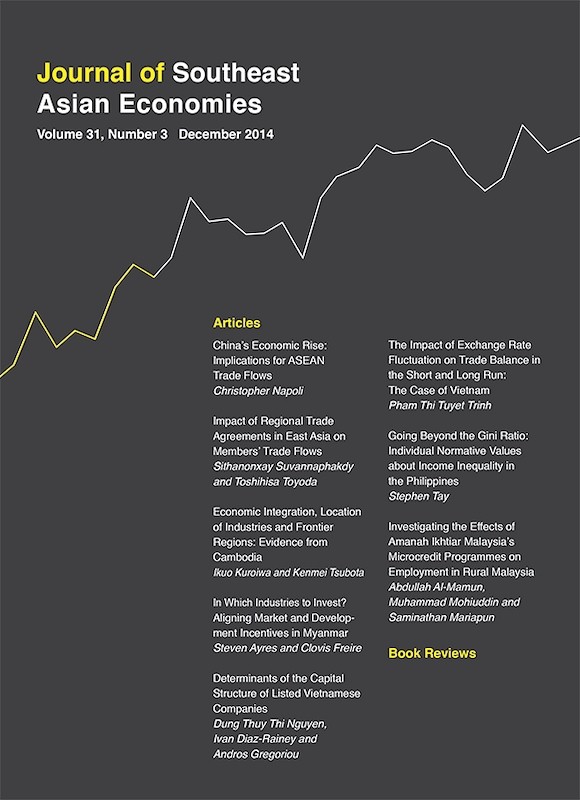ASEAN Economic Bulletin Vol. 26/3 (Dec 2009)

Date of publication:
December 2009
Publisher:
Institute of Southeast Asian Studies
Number of pages:
93
Code:
AE26/3
Contents
-
ASEAN Economic Bulletin Vol. 26/3 (Dec 2009)
[Whole Publication] -
Preliminary pages
- ARTICLES
-
The Impact of Regional Integration and Third-Country Effects on FDI: Evidence from ASEAN, by Nathapornparn Piyaareekul Uttama, NIcolas Peridy, authors see abstractThis paper is aimed at providing a better understanding of FDI determinants in the main ASEAN countries through new developments in FDI theories. This paper simultaneously explores bilateral, third-country as well as regional integration as determinants for FDI. As an extension to the existing literature, it first proposes a theoretical framework which builds on and extends the work of Baltagi, Egger, and Pfaffermayr (2007) by including the impact of regional integration. The theoretical model is then tested empirically for FDI flows from the United States to five ASEAN countries, i.e., Singapore, Malaysia, Thailand, Indonesia and Philippines, over the period 1995-2007 for fifteen industries. Alternative panel data models are considered, especially models with spatially correlated residuals. The results show that third-country effects and regional integration are significant determinants of FDI in ASEAN countries, especially for vertical and complex vertical FDI.
-
Social Acceptance and Readiness for the Knowledge-based Economy in Malaysia, by Ming-Yu Cheng, Sayed Hossain, Jie-Hui Guo, authors see abstractThis paper examines Malaysians' readiness in meeting challenges in the new economy. The model is built based on the hierarchical model of awareness, involvement and contribution. The findings indicate that on average, Malaysians are still at the low level of readiness to assume the knowledge-based economy, despite government efforts to promote the new economy nationwide. Currently Malaysians are at the level of knowing what is going on, but not taking enough effort to participate and contribute to the development of the new economy. The findings support the hierarchical model, in which economic transformation towards the new economy undergoes phases of awareness, involvement and contribution.
-
Gravity Model by Panel Data Approach: An Empirical Application with Implications for the ASEAN Free Trade Area, by Nguyen Trung Kien, author see abstractThis paper examines the determinants of export flows of countries in the ASEAN Free Trade Area (AFTA) through estimations of panel data using a gravity model. In particular, the paper employs the Hausman-Taylor (HT) estimation for a country panel data of thirty-nine countries during the period 1988-2002 based on a two-way error component form of the gravity model. The estimations show that export flows increased proportionately with GDP, and that the formation of AFTA has resulted in significant trade creation among its members. Finally, the paper suggests that trade facilitation policy can play an important role in setting the stage for AFTA's transition to a Free Trade Area.
-
Macro Volatility and Financial Crisis in Thailand: Some Historical Evidence, by Piriya Pholphirul, author see abstractThis paper uses national income identity to explain the causal relationships among Thailand's aggregate volatility, deficient financial structure, financial liberalization, and financial crisis in this country. Relatively good macroeconomic policies and diversified structure were able to compensate for financial imperfections and weak corporate governance in the financial sector in the period 1970-90. Under these conditions, real GDP growth was positive, inflation was relatively low, and consumption was relatively less volatile than GDP. The 1997 crisis, however, severely affected the ability of central authorities to smooth fluctuation. Investment and consumption volatility increased substantially. This implies that, when counter-cyclical policies are difficult to implement and incomplete markets exist, it is much more difficult to stabilize consumption.
- RESEARCH NOTES
-
Ageing in Asia: Trends, Impacts and Responses, by Jayant Menon, Anna Cassandra Melendez, authors see abstractBy the middle of this century, Asia's elderly population is projected to reach 922.7 million, and its share of population 17.5 per cent from just 4.1 per cent in 1950. Within the next few decades, Asia is poised to become the oldest region in the world; reforming policies and creating new structures and institutions to address this challenge is a huge and complex undertaking that requires a big head start. This paper analyses the impact that ageing is having in Asia; examines the policy options for dealing with the problems it is causing, and outlines how different sub-regions may require different responses.
-
Malaysia as an International Halal Food Hub: Competitiveness and Potential of Meat-based Industries, by Pazim Othman, Irfan Sungkar, Wan Sabri Wan Hussin, authors see abstractAs outlined in the Third National Agricultural Policy (NAP3), there is a need to enhance competitiveness and to increase value-addedness to the whole supply chain as well as to position Malaysia as an international halal food hub. This seems to be a noble idea but the paper argues that its implementation as a national policy must still be critically assessed and evaluated as it has far-reaching implications for the national economy. This paper discusses the concepts and trends related to supply chains and then relates it to several possible "hub" concepts that is relevant to Malaysia's policy to become an international halal food hub. The paper then provides an overview of the domestic halal meat industry, including its present structure, major companies, achievement of food safety, quality and halal certification and major issues faced by the industry. It then discusses the potentials of global meat products. Finally, brief policy considerations are discussed.
- BOOK REVIEWS
-
BOOK REVIEW: Institutions and Regional Development in Southeast Asia: A Comparative Analysis of Satun (Thailand) and Perlis (Malaysia), by Edo Andriesse, by Robert L Curry, Jr., author
-
BOOK REVIEW: Economic Cooperation between Singapore and India: An Alliance in the Making? by Faizal bin Yahya, by Jayati Bhattacharya, author
-
BOOK REVIEW: Routledge Handbook of International Political Economy: IPE as a Global Conversation, edited by Mark Blyth, by Francis E Hutchinson, author
-
BOOK REVIEW: Indonesia Betrayed: How Development Fails, by Elizabeth Culler Collins, by Angsoka Yorintha Paundralinga, author






